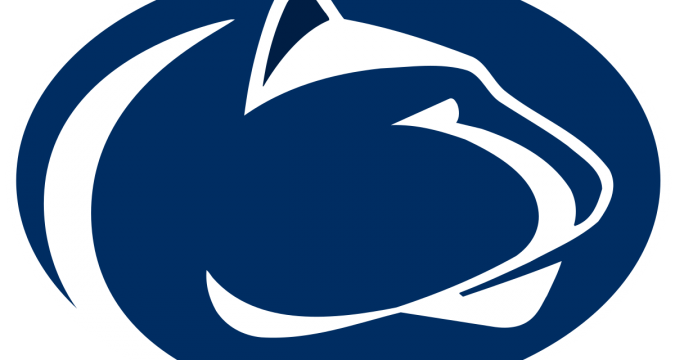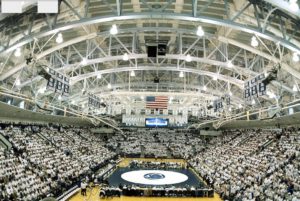
My Introduction to Intercollegiate Wrestling.
In 1944, while a naval aviation cadet at pre-flight school, I was introduced to intercollegiate (amateur) wrestling, both as an instructional and a competitive sport. The wrestling textbook used by the instructors, Championship Wrestling (Annapolis, 1943), was co-authored by Lt. Commander Charles M. Speidel, Cliff Keen, and Ray Swartz. After the war and enrolling as a Penn State student, I was attracted to the sport and learned, to my surprise, that Penn State’s coach was also that co-author, Charles Speidel. I became a fan of his and the wrestling program from that time on.
In those post-World War II years, a typical Saturday afternoon and evening, during the Winter-Spring semester, for many students consisted of viewing sporting events involving the gymnastics, boxing, wrestling, and basketball teams at Rec Hall. Boxing was considered the premier event and, as such, was staged as the last event of the day. Rec Hall was the place to be since there was little else to do except attending a movie or seeing an occasional play at Schwab Auditorium.
The wrestling dual-meet season culminated in the much anticipated and very competitive EIWA championships. Perennial contenders for the championship included Lehigh, Cornell, both service academies, Pitt, Syracuse, Penn State, and occasionally two New Jersey universities, Rutgers and Princeton. Though the league affiliations for the Nittany Lions have changed and coaches and wrestlers have come and gone, the sport still remains much the same (except for the introduction of the “tilt” and the interpretation of the “stall call” as it was in the post-war years and centuries before). But the objective remains the same: “Put your opponent on his back!”
Russ also provided the follow items, gleaned from his research on the history of Penn State wrestling:
Hands off, Navy!
After a Navy meet in Annapolis in February 1936, Coach Charlie Speidel had the following comments: “In those years teams had to complete with the Naval Academy at Annapolis. Maybe once in four or five years would they give us a meet at home. In 1936 Navy insisted on having their medical doctor examine our wrestlers. Our boys were given a thorough test of hopping, climbing, blood pressure, eyes, and throat examinations, etc. The doctor said that Sammy Wolfson shouldn’t box—which he didn’t. He wrestled and won. [J. H.] Krupa had a bad throat and [J. S.] O’Dowd had high blood pressure. Others were so-so. Our ‘sick’ lads won handily [24–6] from the choice manhood of the nation. After that treatment, we had our medical doctor give us a signed slip that our boys were fit—and, to the Navy, please keep hands off!”
Down Memory Lane—Lehigh and Lewis
A column, “Down Memory Lane,” written by Lehigh’s renowned coach, Billy Sheridan, appeared in the program for the Penn State-Lehigh dual meet held in Bethlehem, Feb. 10, 1940. It contained two items of interest to Penn State fans:
“Welcome State! Your presence tonight revives many memories. It does not require much of an effort to visualize the presence on the mat of young men wearing the Blue and White. Away back, I see a Shollenberger [J. H., Lion wrestling coach for a year], a Lamb [Levi, in whose honor the Penn State Levi Lamb scholarship fund was established], a Detar [D. D., Lion wrestling coach for three years], a Higgins [Bob, head Lion football coach for many years], a Carey [L. A.], a Long [several Lion wrestlers with this name], and our own buttermilk purveyor, Cliff Mowrer. In the comparatively modern group, I see a Johnson [J. K.], a Rosenberg [M. L.], a Shaffer [R. P.], a Cole [C. H.], and many others who were a credit to Penn State. Who was the King? I wouldn’t know, but if you press me, I’ll take Shollenberger.”
(Shollenberger, who wrestled for Penn State from 1911 to 1913, won 11 and lost 2. Of his 11 victories, ten were falls. He was captain of the 1913 team and also coached the team during the 1914 season.)
The second item by Sheridan in that program: “Away back in 1931 the NCAA wrestling championships were held at Brown University. Walter O’Connell, wrestling coach at Cornell, and I were chatting about this and that in the wrestling world. A stranger walked over and smiled as he offered his hand. Both O’Connell and I jumped to grasp that hand, recognizing that square jaw and those keen blue eyes. His face was pinched and his hands were thick with calluses. He had the same defiant ‘chip-on-the-shoulder’ look we both had learned to respect. Who was he? He was Doc Lewis, one of the greatest wrestling coaches the world has ever known and a former Penn State coach [Lewis was the first Lion coach and served three stints in that capacity—1909–13, 1915–17, and 1920–21]. By subtle pumping, we soon learned that he had time off even from that ditch-digging job, which meant he wasn’t eating too regularly. Johnny Engel won the 118-pound title for Lehigh at that tournament, and naturally I was happy. But I never was able to erase the memory of Doc Lewis as he looked that day. I wonder where he is today. I would like very much to know.”
A Surprise for Charlie
In the Centre Daily Times of March 3, 1941, the Monday after the Army dual meet, where the four seniors on the squad, Captain Frank Gleason, Joe Scalzo, Joe Falla, and Chuck Rohrer, chalked up impressive triumphs to close their varsity dual-meet careers, the following column, “Gesture,” appeared:
“Here is modesty at its very highest—Charlie Speidel, coach of Penn State’s once-beaten wrestling Lions, was probably the most surprised person in Rec Hall Saturday night when he was awarded a duly-inscribed scroll and radio by his many Penn State fans and friends.
“At noon Saturday, Charlie was all broken up. When his wife asked what the trouble was, he said, ‘I think some of the fellows are getting up a scroll and some sort of present for Leo Houck (men’s boxing coach), and they don’t seem to want me in on it. The scroll read, ‘We in testimony of our appreciation of your splendid contribution to college athletics, your wholesome influence on the young men of this community, your service to Penn State, your success as a teacher, and your ability to win or lose with the same smile, do hereby affix our signatures this first day of March, 1941 A.D.’
“A noble gesture exacted at the right place and the right time.”
Teacher teaches pupil not quite everything
On Jan. 20, 1945 Paul Campbell’s Penn State wrestling team scored a surprising 14–12 win over Cornell. [Campbell replaced Charlie Speidel as coach for four years during World War II.] Glenn Smith, who later would become Bellefonte High School’s wrestling coach, was an ex-serviceman, and he clinched the Cornell meet by pinning his 165-lb. opponent, a fellow townsman from Mt. Carmel, PA.
The Jan. 23rd issue of the Centre Daily Times reported the following: “The best story of the week came out of the Penn State wrestling meet Saturday night when Jack Raskoski, a Cornell wrestler, looked across the mat and saw Glenn Smith of the Lions, his 165-lb. opponent. He then unwittingly remarked, ‘There’s my old coach wrestling for Penn State.’ The remark created quite a furor for a few moments, and the Cornell coach saw fit to summon Lion coach Campbell to ask him about it.
“It turned out rather innocently, however, when Smith explained that he had coached Raskoski for only a few weeks when the high-school coach in their home town was ill. Both come from Mt. Carmel, where Smith had wrestled and where Raskoski was wrestling when Smith returned home a year before entering college. After Smith pinned Jack, Lion coach Campbell was heard to say, ‘He apparently taught him only what he wanted him to know.'”

